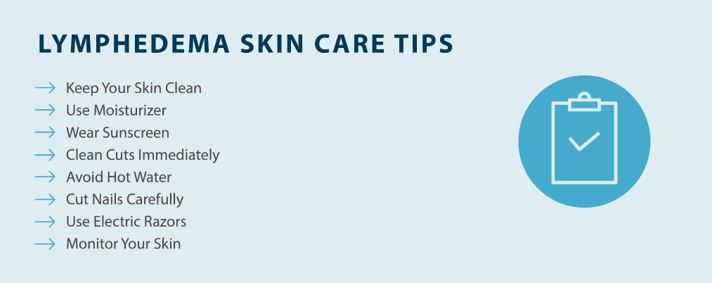How Do You Treat Lymphedema Skin?
There are several lymphedema solutions that can help manage your lymphedema and decrease the risk of progression and complications. One component of lymphedema management is good skin care to help reduce these risks. Follow the lymphedema skin care tips below to manage your symptoms:

Keep Your Skin Clean
The first skin care tip for lymphedema is to keep your skin clean. You’re more susceptible to infections as a result of your lymphedema, so make sure you’re keeping your skin clean to prevent infections.
To keep your skin clean, ensure you’re using the right type of soap or soap substitute for your skin. You don’t want to dry your skin out and make it susceptible to cracking and infections. Look for soaps that are mild or skin cleansers that are moisturizing, hypoallergenic, and have a neural or low pH. Avoid products that have perfumes or dyes added. When you are finished washing your skin, dry your skin carefully, especially any skin folds, to reduce moisture and prevent the growth of bacteria. When you’re finished washing your skin, dry it off thoroughly to reduce moisture and prevent the growth of bacteria.
Use Moisturizer
Cracks in your skin can make it easier for bacteria to enter. Lymphedema patients often have dry skin, so it’s important to ensure it’s moisturized throughout the day.
Using a moisturizer keeps your skin hydrated. An emollient can help you keep your skin moisturized and help prevent irritation, such as itching. Shop for lymphedema moisturizers that contain a minimal amount of harsh chemicals and fragrances to keep your skin moisturized without causing any other complications. Ointments, bath oils, soap substitutes, and moisturizers are all great options for coating your skin with an oily layer and protect from water loss.
Wear Sunscreen
Sunburn can cause significant damage to lymphedema patients, including blisters and boils that can easily become infected, so wearing sunscreen or covering up with clothes is essential when you’re spending time out in the sun. Lymphedema patients should wear sunscreen year-round, including the winter and cloudy days. All weather conditions can cause sunburn, and lymphedema patients with weakened skin barriers are more susceptible to skin damage.
Clean Cuts Immediately
Wound care is crucial even if you don’t have lymphedema, but cleaning wounds quickly is especially important when you’re trying to prevent lymphedema complications. If you have a cut or nick on your limb or an area affected with lymphedema, make sure you clean the cut or scratch as soon as possible to prevent infection.
Start by cleaning your cut with clean water; make sure the water you’re using comes from a clean source, not a natural body of water or a pool. Once you’ve thoroughly cleaned your cut with water, you can apply an antiseptic cream or ointment and cover it with a bandage to avoid infections.
Avoid Hot Water
In any person, hot water can lead to increased swelling due to blood vessels expanding. While hot water doesn’t pose any risks to most people, this increased swelling can be harmful to lymphedema patients. If you’re living with lymphedema, you should avoid soaking the affected limb(s) in water that’s warmer than 102 degrees Fahrenheit because temperatures exceeding 102 degrees can lead to increased swelling.3
If you plan on taking a bath, make sure you’re not soaking the affected limb for a prolonged period of time. Additionally, never wear compression garments when showering or bathing. If recommended by a doctor, wrap your bandages in a plastic bag to prevent them from getting wet.
Cut Nails Carefully
Any little scratch or cut can lead to an infection when you have lymphedema, and those infections can cause complications like cellulitis. Cutting your nails correctly is a vital part of lymphedema skin care if you want to avoid injuries and infections.
When cutting your nails, make sure you’re cutting your fingernails short using a pair of nail clippers, not scissors. You should avoid pushing the cuticles on your fingernails back. As far as your toenails go, you should cut them short and straight across. You can work with a podiatrist to make sure you’re not developing ingrown toenails or experiencing other complications as a result of how you cut your toenails.
Use Electric Razors
It’s important to remember that living with lymphedema means any small cut can turn into an infection that leads to serious complications. With that said, it’s best to avoid standard razors when shaving legs, armpits, your neck, or other areas.
Electric razors are a lot safer than standard manual razors and can help prevent cuts that can lead to infection. Electric razors have built-in protection that ensures you’re cutting your hair instead of your skin.
Monitor Your Skin
Despite all the preventative care, skin-related complications can still occur as a result of lymphedema. The most important thing you can do is to monitor your body and look for any lymphedema skin changes. Your skin might become thicker and hardened, or you may notice discoloration. If you’re experiencing these changes, you should talk to your doctor or specialist.
Monitoring your skin also helps you spot any potential complications before they become too serious. A minor cut or infection can be dealt with if you don’t let it progress, but a serious infection is much harder to treat. Don’t hesitate to call your doctor if you’re experiencing any skin-related issues.

